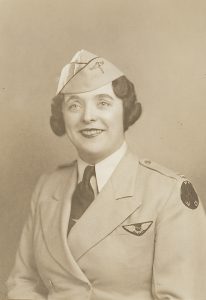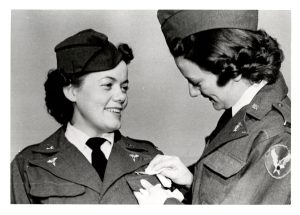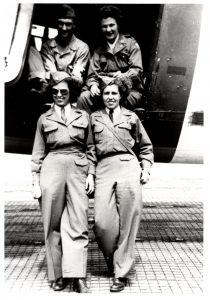The Aerial Nurse Corps of America
Part 6
To avoid possible misunderstandings of Aerial Nurse Corps of America (ANCOA) activities, by 1939 its founder, pilot Loretta Schimmoler, had appointed a registered nurse, Ruth G. Mitchell, as Chief of Staff. In August 1939 Mitchell explained to delegates of the California State Nurses’ Association meeting in San Francisco, “This has always been the plan of the Founder to have some one direct the Nursing activities and thus to meet all the requirements of the Nursing standards.” She emphasized, “This is wholly a nursing project and is designed to serve the daily needs of the public through aeronautical means,” glossing over the fact that Schimmoler was a pilot but not a nurse. After reviewing how and why ANCOA was founded and reiterating its aims, Mitchell outlined a plan to forge a link between ANCOA and the state nurses’ associations:
Advisory Councillors are to be chosen in each State and will thereby represent her respective State Nurses Association. They will act as advisors within the ranks of the Aerial Nurse Corps on professional requirements, as well as mediators within the Association for future demands to be made in aviation for the safety of the nurse, the patient and the aircraft operator.
She then recommended that the California State Nurses’ Association establish an advisory council to investigate ANCOA, accept it as a nursing project, and endorse its activities. Recognition by the American Nurses Association (ANA) was the ultimate goal:
The passing of the recent Nurse Practice Act gives the California State Nurses Association the right to determine who is qualified to care for the sick on land, in hospitals, homes etc., and it is only logical for them to also determine who is qualified to care for the sick in the air and for all aviation activities. The establishing of this Advisory Council for the Aerial Nurse Corps will make this possible and through the council the standards for future aeronautical nursing will thus be determined by a recognized nursing board. 1
While Mitchell was courting the California State Nurses’ Association, Mary Beard, Director of Nursing of the American Red Cross (ARC), continued to express her concern about ANCOA activities. She presented a report on that organization at a meeting of the Board of Directors for the ANA in January 1940, carefully pointing out that Schimmoler, who founded ANCOA, was not a nurse. After stating the purposes of ANCOA and summarizing facts on the organization gleaned from the literature and from correspondence, Beard stressed that
There is no connection, formal or informal, between the American National Red Cross and the Aerial Nurse Corps of America, Inc. This should be borne in mind, inasmuch as one may read in the pamphlet from which I have just been quoting such a statement as the following: “The Aerial Nurse Corps should be called into service through the American Red Cross, the Army, the Navy, or any other civic or military group placed in charge at the time the emergency should arise.”
Concerning Schimmoler’s attempts to receive the backing of the ANA, Beard wrote:
In at least two of the states an approach has been made to the state nurses’ association, and these state nurses’ associations have considered the appointment of an advisory committee on the ANCOA. I am unable to say whether or not such advisory committees are now active, or even that they were ever actually appointed.
Beard closed her report with a reference to the military’s view on flight nursing:
On more than one occasion during the past two years there have been conferences about aerial nursing between the representatives of the Army Nurse Corps, the Navy Nurse Corps, and the American Red Cross. Each time the Nursing Service of the Red Cross has been assured that neither the Army nor the Navy wishes to request any special action in regard to the services of nurses in the air. 2
As recommended by Mitchell, the California State Nurses’ Association appointed an Advisory Committee to ANCOA. A copy of the committee report on ANCOA letterhead dated 14 October 1940 reflects the influence of the ambitious Schimmoler in its list of seven recommendations that included:
1. We recommend the approval and recognition of the Aerial Nurse Corps of America for the development of an aviation department for the nursing profession under the National Defense Program.
2. Recommendation to the C.S.N.A. for the formal approval of the standards and enrollment of the Aerial Nurse Corps of America which includes membership in the American Nurses Association and the American Red Cross Nursing Service.
3. Recommendation for the creation of an Aerial Nurse Corps roster in the Red Cross Nursing files for any and all forms of aviation duty for national emergency under the direction of the American Red Cross.
Across the top of a copy of the recommendations Badger had written “Miss Beard – This is the one I refused to sign. GLB.” 3
Badger, who was a member of the advisory committee, sent Beard copies of recent correspondence between herself and Schimmoler. “I think that great confusion exists and in my letter I have tried to clarify my position as a member of the Advisory Committee which was appointed by the California State Nurses’ Association,” Badger explained. 4 Writing to Badger, Schimmoler had implied that Emily K. Eck, the chairman of a Special Committee appointed by the ANA, had asked her – Schimmoler – to appoint a committee to confer with this Special Committee. Schimmoler continued:
Inasmuch as they have asked us to appoint a committee to confer with the Special Committee in the ANA, and inasmuch as we already have a functioning committee in the CSNA – ANCOA Advisory Committee, we believe it is only fitting and proper that this Committee represent ANCOA before the A.N.A. Committee. 5
Badger’s reply to Schimmoler left no doubt as to her own feelings on the matter:
It is evident there is confusion regarding the relationship of the C.S.N.A. Advisory Committee to the A.N.C.O.A. and of its individual members.
First of all, I wish to make clear my relationship to the A.N.C.O.A. by stating the following facts:
I am a member of the California State Nurses’ Association and as such I was appointed by the State Association on the Advisory Committee to the A.N.C.O.A. I am not a member of the A.N.C.O.A.
From your letter it is my understanding that the chairman of a Special Committee appointed by the American Nurses’ Association has written you, asking you to appoint a committee to confer with this Special Committee. It would seem to me that such a committee is intended to be composed of members of the A.N.C.O.A.
In view of the above, I am returning unsigned the recommendations which you attached for my signature. 6
In wording similar to that found in the 14 October 1940 report, one of the six recommendations to which Badger referred included “The creation of an Aerial Nurse Corps roster in the American Red Cross Nursing files for any and all forms of aviation duty in national emergency under the direction of the American Red Cross Nursing Service”. 7 In a 30 October letter to Beard in which Badger enclosed these recommendations dated 26 October, Badger shared yet another way in which Schimmoler was trying to situate her organization under the aegis of the ARC – and was “working the crowd”:
In talking to some of the younger nurses during the California State Nurses’ Convention I was told that Miss Schimmoler had suggested that when they send their applications to us for enrollment they indicate that they would prefer service in the Aerial Nurse Corps. I explained to the nurses that their applications would be returned to them since at present the only provision we have is for a Reserve for the Army and Navy. 8
The Special Committee of the ANA to confer with the ANCOA met on several occasions. It reviewed correspondence with ANCOA as well as organizational and other aviation literature. The chair of the committee, Emily Eck, provided an outline of content for the training of aviation nurses. 9 The committee members consulted airline company officials and arranged conferences with several people, among them the superintendents of the Army and Navy nurse corps. Of particular interest in the notes that Dunbar forwarded to Beard was the report that Schimmoler apparently was willing to step down from her leadership position of ANCOA and leave it in the hands of nurses as soon as she felt that the organization could take care of itself. Schimmoler was not likely to disappear from the scene, however, as Dunbar explained:
The nurses in the group are quite concerned to find the proper way for Miss Schimmoler to continue to give what they consider her great contribution, especially in the field of the construction of aeroplanes for transporting sick people safely. A great deal was made of the fact that the ideal place for Miss Schimmoler would be on a national advisory committee to the Red Cross on the use of planes in disaster. 10
After very careful consideration of the information obtained, the Special Committee of the ANA to confer with the ANCOA made the following recommendations:
I. That formal recognition of the ANCOA in its efforts to develop aviation instruction and training for the nursing profession, be withheld for the following reasons:
(a) The ANCOA is non-professional in that its president is a lay person person – not a nurse. …
(b) The training which the ANCOA nurses are receiving at the present time, in the opinion of the committee, does not prepare them adequately for the nursing service they would be expected to render in the event of disaster. …
II. That in view of the above recommendations, the ANA advise that the State Advisory Committees to the ANCOA, which have been appointed, be dissolved.
III. That if the ANCOA should reorganize and select as its president, a qualified nurse, the ANA consider ways and means of developing a close affiliation with that organization.
IV. That a short course of instruction designed to prepare graduate nurses for nursing service in the air, be made available to qualified nurses. …
V. That the National League of Nursing Education be asked to develop an outline for such a course.
VI. That the outline be sent to the American Red Cross for trial in several of the Red Cross Chapters to determine its effectiveness.
VII. That recommendation IV be referred to the Nursing Council on National Defense.
VIII. That the American Red Cross be requested to organize a Reserve of nurses, qualified to constitute an organized group for any and all forms of nursing duties in aviation, in the event of civic or national emergencies. 11
The Special Committee of the ANA to confer with the ANCOA submitted its report to Julia C. Stimson, President of the ANA, on 16 May 1941.
About a week later, Schimmoler appointed Leora Stroup as president of ANCOA. Eileen Newbeck was named to fill Stroup’s position as Detroit Company commander. “CONGRATULATIONS AND SINCEREST GOOD WISHES FOR EVERY SUCCESS AS YOU TAKE OVER WHERE I LEAVE OFF” read a telegram from Schimmoler to Stroup on 24 May 1941, which continued:
HAD IT NOT BEEN A STORMY NIGHT YOU WOULD HAVE BEEN WITH ME FROM THE START IN 1932 WHAT COULD BE MORE APPRORIATE [sic] THAN TO HAVE A FELLOW NINETY NINE FOLLOW IN MY FOOTSTEPS FAITH AND DETERMINATION HAS BROUGHT US THROUGH TOGETHER OYALTY [sic] SHALL KEEP US TOGETHER LOVE=LAURETTA 12
 Leora B. Stroup [US Army Medical Dept Museum]
Leora B. Stroup [US Army Medical Dept Museum]
Stroup then submitted a reorganization plan for ANCOA that included the following changes:
1. The organization to be an all-nurse group.
2. Emphasis on greater coordination with all local and national defense organizations.
3. More State Nursing Association Committees as Advisory Committees.
4. A simple form of Constitution and By-Laws adopted to fit the present emergency needs.
5. An effort for increased membership.
6. Lowered membership fees.
7. Simplification of clerical procedures, for leaders of local groups.
8. Monthly educational mimeographed publication on aviation nursing, research and current events to all members.
9. Consideration of the courses of study by local Leagues of Nursing Education with a view toward help and approval.
10. A conference of the nurse-leaders of the Great Lakes area this month.
11. Submitting the new set-up of the organization to the ANA Special Committee to get their help, guidance and support.
12. Formal approval by the Board of Directors of the American Nurses Association. 13
In yet another effort to comply with ANA directives, Schimmoler established the Aviation Emergency Corps, a ground staff of clerks, radio operators, first aid workers, and other women with some experience in the flying industry, separate from the all-nurse component of ANCOA. The newly designated organization would apply itself to home defense by augmenting emergency services at all airports, landing fields, and aircraft factories with persons adequately trained in both aviation and emergency work “in the event of disaster or attempted destruction in time of war”. 14
The Civil Air Patrol, which had been created in December 1941 as a non-combat voluntary auxiliary of the United States military, was another focus of ANCOA collaboration. Stroup, who was the deputy medical officer of the Detroit women’s squadron of the Civil Air Patrol, one of her “pet projects” in aviation, likely used that platform to coordinate ANCOA activities with this national defense organization. By 1942 ANCOA members had joined the ranks of the Civil Air Patrol but maintained some degree of autonomy by gaining permission to wear their own uniforms on which Civil Air Patrol insignia was displayed. 15
With the intent to make more educational resources available for aerial nurses, in the fall of 1941 Stroup began corresponding with Major Harry G. Armstrong, Commandant of the School of Aviation Medicine at Randolph Field, Texas and author of Principles and Practice of Aviation Medicine (1939), about adapting the book for the use of ANCOA nurses. With a conditional go-ahead from his publishers, Armstrong gave thought to how the book might be revised. Both he and Stroup must have had second thoughts about their collaboration, however, for Armstrong declared himself unwilling to commit definitely to preparing the book until he had read the outline proposed by Stroup for her chapter on the place of nurses in aviation medicine. Stroup, in the meantime, had been so swamped with work that she was unable to follow through on her contribution to the book. The project apparently was dropped. 16
Changes made in the ANCOA organization were likely too little, too late. The ANA did not revisit the status of ANCOA. Whether this had anything to do with a possible rift between Schimmoler and Stroup involving the ANCOA presidency to which Ruth Nichols of Relief Wings alluded in a letter to Harriet Fleming in 1942 is uncertain. Nichols wrote: “Miss Schimmoler also advised me that a Miss Stroop [sic] from Detroit, who had been appointed president because it was required by the A.N.A. to have a registered nurse head such an organization, had resigned and as she put it, threw the responsibility back in her lap and that she, Miss Schimmoler, was again President!” A letter from Schimmoler to Stroup in June 1942 implies a possible “falling out”: “I had not heard from you for so long that I begin [sic] to think that I would never hear from you again, and sincerely, Leora, I have never had anything to crush me as much as our break in friendship.” 17
Perhaps the lingering discontent of ANA leaders with ANCOA was not only that Schimmoler was not a nurse, but also that, as was the case with Relief Wings, ANCOA threatened to exert unwarranted control over the limited number of nurses available for wartime needs. And the need to mobilize the ARC First Reserve of nurses for military service and to fill resulting civilian vacancies would have taken precedence over continued study of the ANCOA situation. With articles such as “American Nurses – We Are at War!”, “First Reserve Quotas!”, “Nurses, to the Colors!”, and “The Time Is Now!” appearing in 1942 in the American Journal of Nursing, the ANA clearly had more pressing issues occupying its time.
Schimmoler had failed in her efforts to achieve formal ANCOA recognition by the professional nurse organization. Ultimately the rivalry between the two organizations was “much ado about nothing”. But the deliberations and decisions of nurse leaders of the ARC and the ANA concerning Schimmoler and ANCOA offer insight into how nurses sought to maintain control of their profession as America headed toward its involvement in World War II.
To be continued
Notes
1 Ruth G. Mitchell, “The Aerial Nurse Corps of America,” speech given at Meeting of Delegates of the California State Nurses Association, San Francisco, 15 Aug 1939, 4.
2 Mary Beard, “The Aerial Nurse Corps of America, Inc.,” 23 Jan 1940.
3 “Report of the Committee of C.S.N.A.-Advisory Council for A.N.C.O.A.,” 14 Oct 1940.
4 Ida F. Badger, letter to Mary Beard, 30 Oct 1940.
5 Lauretta M. Schimmoler, letter to Ida F. Badger, 28 Oct 1940.
6 Ida F. Badger, letter to Lauretta M. Schimmoler, 30 Oct 1940.
7 Lauretta M. Schimmoler, letter to Ruth G. Mitchell, 26 Oct 1940.
8 Gladyce L. Badger, letter to Mary Beard, 30 Oct 1940.
9 Emily K. Eck, “Course Outline for Aviation Nursing,” [3 May 1941].
10 Virginia M. Dunbar, “Notes on meeting of Aerial Nurse Corps, Saturday, May 3, 1941.”
11 “Special Committee of the ANA to Confer with the Aerial Nurse Corps of America Report.’” [16 May 1941].
12 “Sent to Detroit News Announcing The Annual Dance of the Detroit Group,” 5 Apr 1941.
13 Leora B. Stroup, “Tentative Reorganization Plans,” Aerial Nurse Corps of America, n.d.; Nichols, letter to Fleming, 16 Feb 1942.
14 “The Aerial Nurse Corps of America Announces – Aviation Emergency Corps,” n.d; “Denver Plans to Have Its Own Unit of Aerial Nursing Corps,” Denver Post, 31 Jan 1941.
15 John F. Curry, letter to Lauretta M. Schimmoler, 26 Jan 1942.
16 Leora B. Stroup, letter to Harry G. Armstrong, 11 Oct 1941; Harry G. Armstrong, letter to Leora B. Stroup, 24 Oct 1941; E.F. Williams, letter to Harry G. Armstrong, 31 Oct 1941; Harry G. Armstrong, letter to Leora B. Stroup, 12 Nov 1941; Leora B. Stroup, letter to Harry G. Armstrong, 19 Nov 1941; Harry G. Armstrong, letter to Leora B. Stroup, 24 Nov 1941; Leora B. Stroup, letter to Harry G. Armstrong, 10 Jan 1942.
17 Ruth Nichols, letter to Harriet Fleming, 16 Feb 1942; Lauretta Schimmoler, letter to Leora B. Stroup, 26 Jun 1942.



